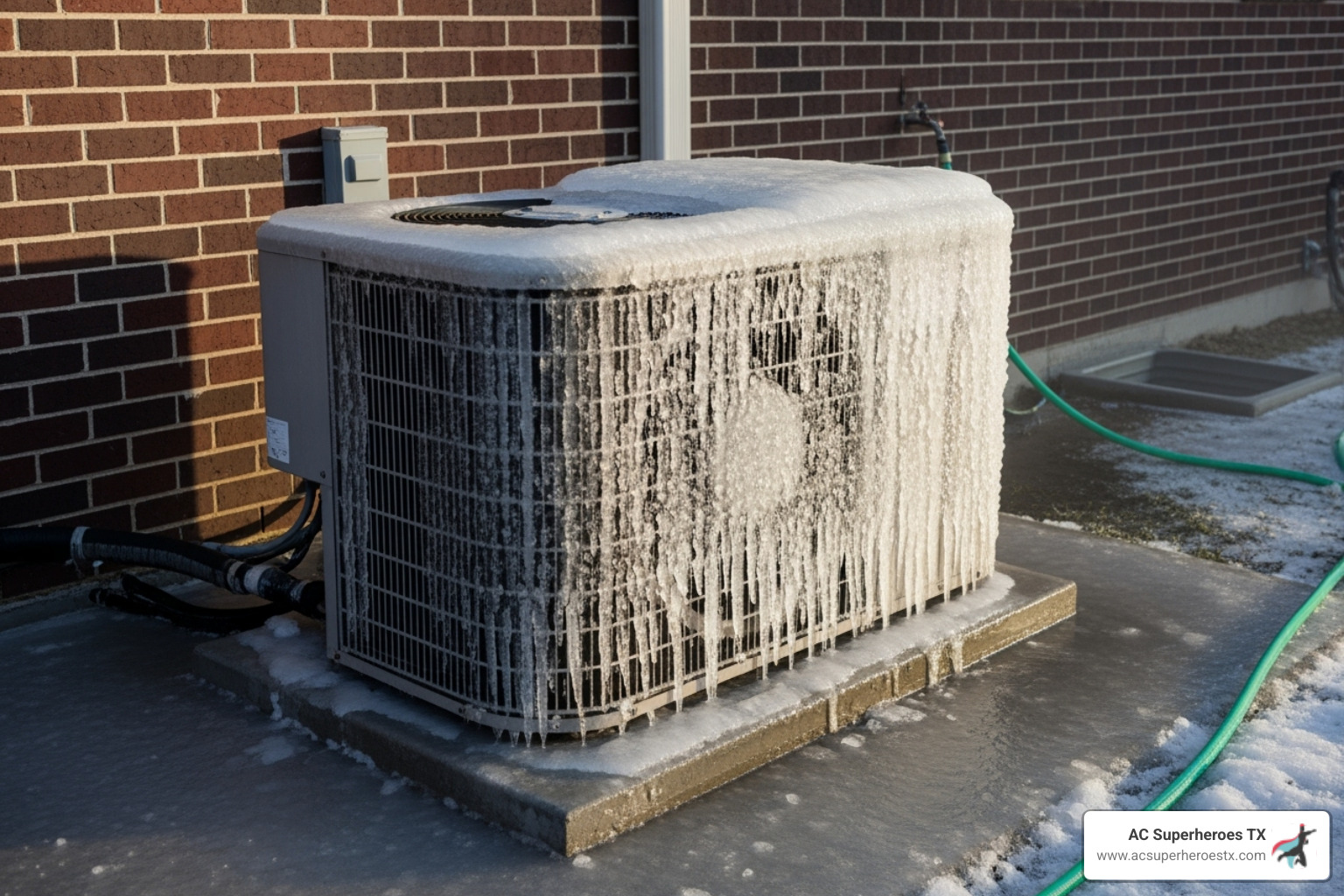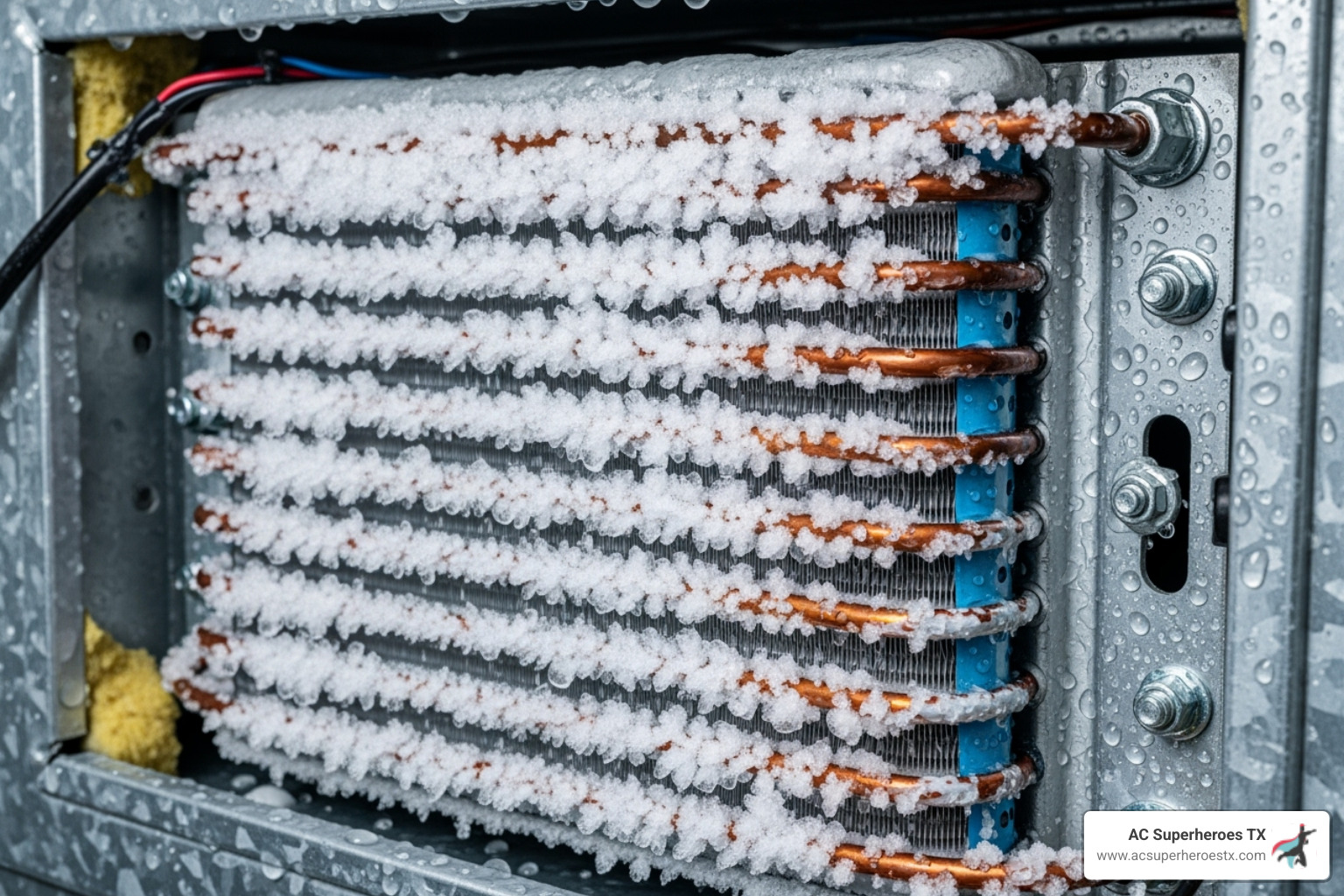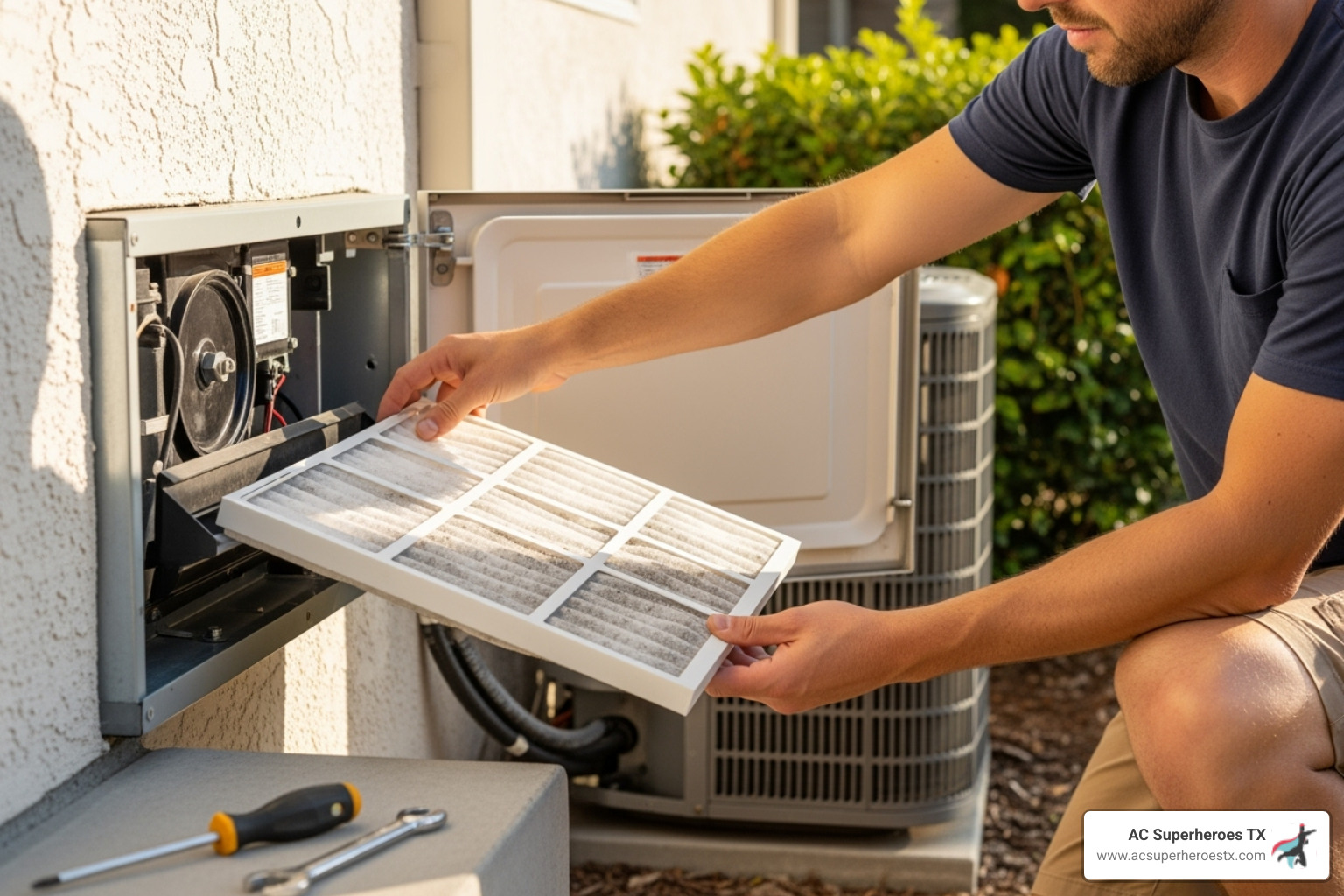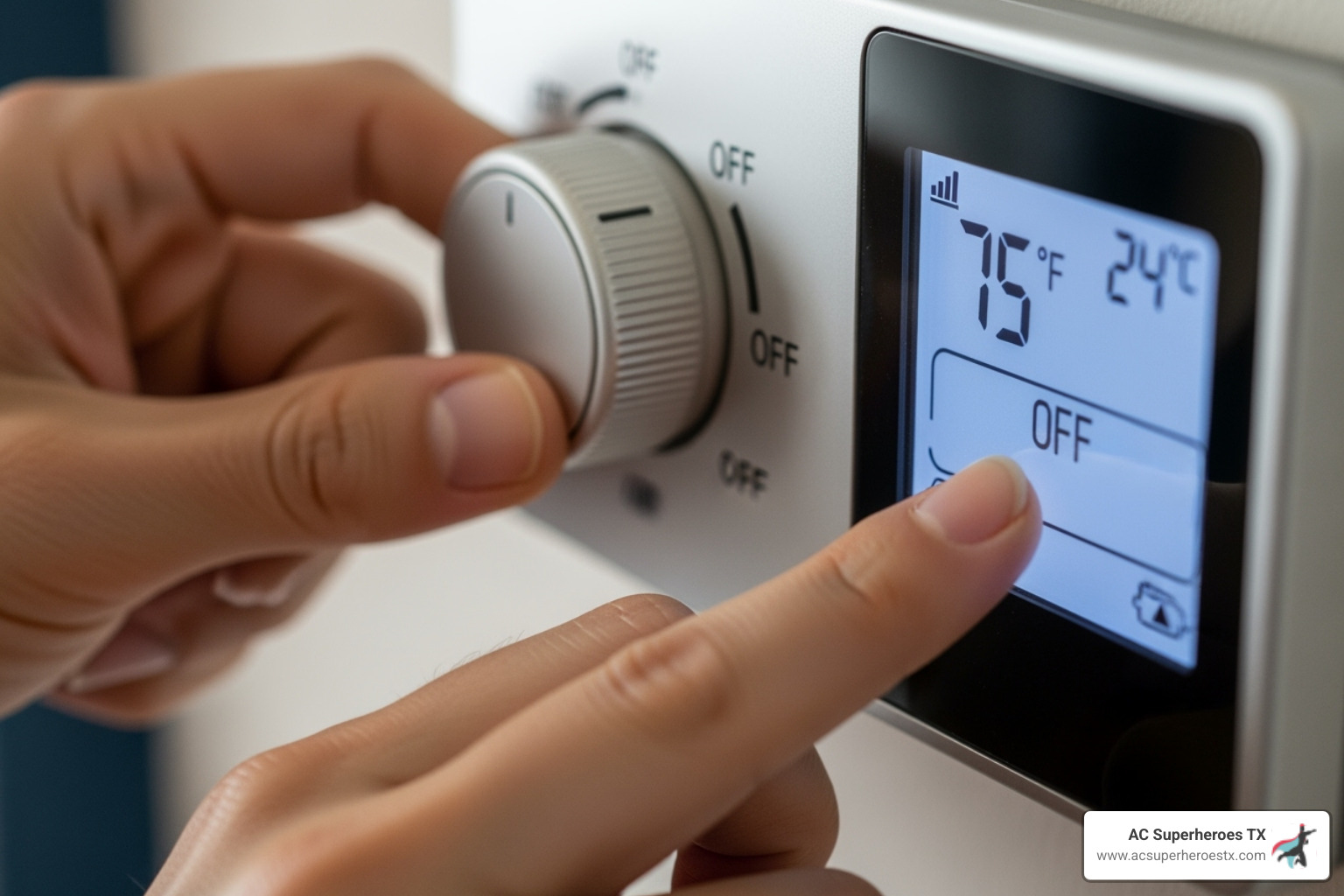AC Freezing Up? What to Do When Your Unit Turns into an Ice Sculpture

AC Freezing Up? What to Do When Your Unit Turns into an Ice Sculpture
When Your AC Turns into a Winter Wonderland: Understanding the Freeze-Up Problem
AC freezing up is one of the most ironic problems homeowners face during blazing Texas summers. Picture this: it's 95°F outside, you're sweating bullets, and your air conditioner decides to become an ice sculpture. Despite how bizarre it sounds, this is actually a common issue that affects countless AC systems every year.
Quick Answer for AC Freezing Up:
- Turn off your AC immediately - Running a frozen unit can damage the compressor
- Set the fan to "ON" to help thaw the ice
- Check your air filter - dirty filters are the #1 cause
- Wait 1-24 hours for complete thawing before restarting
- Call a professional if the problem returns
The main culprits behind AC freezing are:
- Blocked airflow (dirty filters, closed vents)
- Low refrigerant due to leaks
- Running AC when it's too cool outside (below 60°F)
When your AC freezes, it's telling you something is preventing the normal heat exchange process. The evaporator coil, which should absorb heat from your home's air, gets too cold and starts collecting ice instead. This creates a snowball effect that can lead to expensive repairs if ignored.
Research shows that two-thirds of all homes in the United States have air conditioning systems, and many of these experience freezing issues at some point. The good news? Most freeze-ups are preventable with proper maintenance and quick action when problems arise.

Why is My AC Freezing Up? Key Signs and the Science Behind It
Picture this: you're expecting cool air to flow through your home, but instead, your air conditioner has turned into a giant ice cube. While it might sound like something out of a sci-fi movie, AC freezing up is actually a common problem that happens when your system's delicate cooling process gets thrown off balance.
The star player in your cooling system is the evaporator coil, tucked away inside your indoor unit. This coil works like a heat magnet, pulling warmth and humidity from your home's air. When everything's working properly, warm air flows over the super-cold coil, the refrigerant inside absorbs the heat, and moisture naturally condenses and drains away. But when something goes wrong, that moisture turns to ice instead of harmlessly dripping away.

Telltale Signs Your AC is Frozen
Sometimes the ice is obvious, but often your AC sends more subtle distress signals before you actually see any frost. Learning to spot these early warning signs can save you from bigger headaches down the road.
The most obvious clue is visible ice or frost on the copper lines near your outdoor unit or coating the evaporator coil inside your indoor unit. But don't assume everything's fine just because you can't see ice – your system might still be frozen.
Weak or no airflow from your vents is another major red flag. When ice blocks the evaporator coil, air can't flow properly through your system, leaving you with barely a whisper coming from your registers.
Here's something that confuses many homeowners: your AC might actually be blowing warm air even though it's running. When the coil is frozen solid, it can't absorb heat from your home's air, so the air just passes through without getting cooled.
Puddles or water damage around your indoor unit often provide the first clue that something's wrong. As ice melts, it can overwhelm the drain pan and leak onto your floors.
Listen for hissing or bubbling noises too – these sounds often point to refrigerant leaks, which are a common culprit behind freezing problems.
If you're noticing poor airflow, our guide on Signs of Poor Airflow in AC System can help you understand what might be causing the problem.
How Your AC Works (and Why It Freezes)
Your air conditioner is basically a heat-moving machine that relies on a simple but neat relationship between temperature and pressure. Inside your system, refrigerant constantly changes between liquid and gas states to move heat from inside your home to the great outdoors.
The magic happens when liquid refrigerant passes through an expansion valve and its pressure drops dramatically. This sudden pressure drop causes the refrigerant to expand and become incredibly cold – a phenomenon scientists call the Joule-Thomson Effect. Think of it like releasing air from a pressurized tire – the escaping air feels cold because it's expanding rapidly.
This super-chilled refrigerant then flows through your evaporator coil, where it eagerly absorbs heat from your home's warm air. The refrigerant warms up and travels to your outdoor unit, where a compressor pressurizes it again and sends it through the condenser coil to dump all that absorbed heat outside.
Under normal conditions, your evaporator coil runs between 10 and 20°F – cold enough to pull moisture from the air but not so cold that it freezes. But when this delicate balance gets disrupted, trouble starts brewing.
If the refrigerant gets too cold, or if there's not enough warm air flowing over the coil to balance out the cold, the moisture on the coil freezes instead of draining away. Once ice starts forming, it creates a snowball effect that can quickly turn your cooling system into an expensive ice sculpture.
Understanding this process helps explain why AC freezing up isn't just about cold weather – it's about disrupted heat exchange that can happen even on the hottest summer days.
The Top 3 Reasons for an AC Freezing Up
Picture this: you're dealing with a frozen AC unit, and you're wondering what went wrong. The truth is, AC freezing up usually boils down to three main culprits. Think of your air conditioner as a perfectly balanced system – when something throws off that balance, ice starts forming where it shouldn't.

Cause #1: Restricted Airflow
Here's the thing about air conditioners – they're basically heat sponges. Your evaporator coil needs a steady stream of warm air flowing over it to absorb heat properly. When that airflow gets choked off, the coil gets colder and colder until it's literally freezing the moisture right out of the air.
Dirty air filters are the biggest troublemaker here. When your filter gets clogged with dust, pet hair, and debris, it's like trying to breathe through a thick blanket. The air just can't get through to your evaporator coil. According to the U.S. Department of Energy, simply changing your filter can boost your system's efficiency by 5% to 15%. That's a pretty impressive return on a $5 filter! Our guide on Dirty Air Filters Impact AC Performance dives deeper into this common issue.
Blocked vents and registers are another sneaky cause. Maybe you moved the couch and accidentally covered a return vent, or perhaps you closed off vents in unused rooms thinking you'd save money. Unfortunately, this creates pressure imbalances that starve your evaporator coil of the warm air it desperately needs.
Dirty evaporator coils can also cause problems. Over time, these coils collect dust and grime that acts like a winter coat, preventing proper heat exchange. Even with good airflow, a dirty coil can't do its job effectively.
Sometimes the issue is a malfunctioning blower motor – the fan that moves air through your system. If it's not spinning at the right speed or struggling to work properly, you'll get the same freezing problems as a dirty filter. For step-by-step instructions on filter replacement, check out More information on how to change your AC's air filter.
You can also learn more about airflow issues in our article about Signs of Poor Airflow in AC System.
Cause #2: Refrigerant Leaks and Mechanical Problems
Your AC's refrigerant is like the blood in your veins – it needs to flow at exactly the right pressure and volume. When something goes wrong with this sealed system, freezing often follows.
Low refrigerant levels are a red flag that something's not right. Here's an important fact: refrigerant doesn't get "used up" like gasoline in your car. Your AC system is completely sealed, so if refrigerant levels are low, there's almost certainly a leak somewhere.
When refrigerant levels drop, the pressure in your evaporator coil drops too. This causes the remaining refrigerant to expand more than it should, making it get much colder than designed. The result? Ice formation on your coil.
Refrigerant leak symptoms include hissing sounds, bubbling noises, or that telltale ice buildup. But here's the thing – refrigerant is hazardous stuff that requires special handling and certification to work with safely. Simply adding more refrigerant without fixing the leak is like putting a band-aid on a broken pipe.
Damaged refrigerant lines can also cause pressure problems. If the copper lines get kinked or damaged, refrigerant flow gets restricted, leading to the same freezing issues.
A faulty compressor – your system's heart – can create pressure imbalances throughout the entire system. When it's not working properly, it affects refrigerant circulation and can contribute to freezing.
These mechanical issues are definitely in "call the pros" territory. Trying to fix refrigerant problems yourself can be dangerous and expensive. For more detailed information, check out our guide on How to Address AC Refrigerant Line Frost.
Cause #3: Cool Outdoor Temperatures
This one surprises a lot of people, but running your AC when it's too cool outside can actually cause freezing. It seems backwards, but there's solid science behind it.
Air conditioners are designed to work efficiently when outdoor temperatures are above 60-62°F. When you run your AC on cooler nights or during mild spring days, the system struggles with pressure drops that make the refrigerant get too cold.
Think about those pleasant Texas evenings when it's 55°F outside but still warm in your house. Your AC kicks on, but the outdoor conditions cause the system pressure to drop below normal operating ranges. The evaporator coil gets colder than it should, and ice starts forming.
The fix is pretty straightforward. Programmable thermostats can automatically shut off your AC when outdoor temperatures drop too low. If you don't have a smart thermostat, simply turning the unit off and opening windows when it's cool enough outside will do the trick.
Understanding how your thermostat affects your entire system is crucial for preventing these issues. Our article on How Thermostat Malfunctions Affect AC Performance covers this topic in detail.
The good news is that most AC freezing up problems are preventable with proper maintenance and awareness of these three main causes. Whether it's changing filters regularly, keeping vents clear, or knowing when not to run your system, a little prevention goes a long way.
Your Immediate Action Plan: How to Safely Thaw Your AC
Finding your AC has turned into an ice sculpture can be disheartening, but don't panic! Taking the right immediate steps can prevent further damage and help you get back to comfortable cooling. The most crucial thing to remember is to never run your AC unit when it is frozen. Doing so can severely strain and permanently damage the compressor, which is the most costly component of your system. Avoid using sharp tools to chip away at the ice, as this can puncture refrigerant lines or damage the coils. Safety first, always!

[LIST] of Steps to Take When Your AC is Freezing Up
Here's your immediate action plan to safely thaw your unit:
- Turn the Thermostat to OFF: This is the very first and most important step. Shut down the entire system at the thermostat. Do not just turn the cooling off; switch the system to the "OFF" position. This prevents the compressor from running and trying to cool a frozen coil, which can lead to expensive repairs.
- Switch the Fan Setting to ON: Once the system is off, change the fan setting on your thermostat from "AUTO" to "ON." This will run only the blower fan (indoor unit) without engaging the compressor. Circulating air over the frozen coil will help it thaw faster and dry out any excess moisture. Let the fan run for at least an an hour after the ice has visibly melted.
- Allow the Unit to Thaw Completely (1-24 hours): Patience is a virtue here. Depending on how much ice has accumulated, it can take anywhere from 1 to 24 hours for the unit to fully defrost. You might want to place towels around the indoor unit to catch any melting water. If you're in a hurry, some homeowners use a hairdryer on a low, cool setting from a safe distance, but ensure no water gets near electrical components.
- Check and Replace the Air Filter: While the unit is thawing, inspect your air filter. If it's dirty or clogged, replace it with a clean one. This is a common culprit for freezing, and addressing it now can prevent a recurrence.
- Clear Any Blocked Vents: Walk through your home and ensure all supply and return vents are open and unobstructed by furniture, drapes, or other items. Proper airflow is essential.
- Dry the Area Around the Unit: Once thawed, wipe up any puddles or moisture around your indoor unit to prevent water damage or mold growth.
After the unit has completely thawed and you've addressed any obvious airflow issues, you can turn the system back on. Set the thermostat to "Cool" and your desired temperature. Monitor the unit closely for the next few hours to ensure it's cooling properly and not starting to freeze again.
The Dangers of Running a Frozen AC
We cannot stress this enough: do not run your air conditioner when the coils are frozen. It might seem like a good idea to push it a little longer to get some cool air, but the consequences can be severe and costly.
- Permanent Compressor Damage: The compressor is designed to handle refrigerant in a gaseous state. When the coil is frozen, liquid refrigerant can return to the compressor, causing what's known as "liquid slugging." This can burn off the lubricating oil, leading to the compressor motor burning out. Replacing a compressor is often the most expensive repair you can face, sometimes costing as much as a down payment on a new, high-efficiency AC unit. Learn more about why your AC Compressor Won't Start Running.
- Costly Repairs: Beyond the compressor, running a frozen unit can damage other components like the fan motor or electrical parts due to excessive strain or moisture. What might have been a simple filter change could turn into a multi-component repair.
- Water Damage to Your Home: As the ice melts, it can overflow the condensate drain pan, leading to significant water damage to ceilings, walls, and flooring. This can also create a breeding ground for mold and mildew.
- Electrical Hazards: Water and electricity don't mix. Overflowing water from a frozen coil can seep into electrical components, creating a shock hazard or causing electrical shorts that damage the unit or even pose a fire risk.
It's always better to take a temporary break from cooling to allow your system to thaw and recover, rather than risking permanent damage and a much larger repair bill.
Long-Term Prevention: How Regular Maintenance Stops Freezing
Think of your air conditioner like your car – you wouldn't skip oil changes and expect it to run perfectly forever, right? The same principle applies to preventing AC freezing up. At AC Superheroes TX, we've seen countless homeowners avoid expensive repairs and uncomfortable summer days simply by staying on top of regular maintenance.
The truth is, most frozen AC units could have been prevented with proper care. When we perform routine maintenance, we're essentially giving your system a clean bill of health and catching small problems before they turn into big, expensive headaches.
The Role of Regular HVAC Tune-Ups
During a professional tune-up, our technicians dive deep into your system to address the root causes that lead to freezing. It's like a comprehensive physical exam for your AC.
Inspecting refrigerant levels is one of our top priorities. We don't just "top off" refrigerant like some companies do – that's like putting a band-aid on a broken pipe. If refrigerant levels are low, there's always a leak somewhere. We find that leak, fix it properly, and then recharge the system to the correct levels. This prevents the pressure drops that cause coils to freeze.
Cleaning evaporator and condenser coils might not sound glamorous, but it's crucial. Over months of operation, these coils collect an amazing amount of dirt, pet hair, and debris. A dirty evaporator coil can't absorb heat properly, which leads directly to freezing. Sometimes we actually remove the evaporator coil completely to give it a thorough cleaning – something most homeowners can't do safely on their own.
Testing electrical components helps us catch failing parts before they cause bigger problems. A struggling blower motor might not move enough air over the coils. A faulty capacitor could cause your compressor to work inefficiently. These small issues can snowball into freezing problems if left unchecked.
Clearing drain lines prevents water backup that can contribute to freezing. When condensate can't drain properly, it creates moisture buildup around the coil. If that coil gets cold enough, you've got ice formation waiting to happen.
Ensuring optimal airflow ties everything together. We check your blower motor's performance, inspect ductwork for leaks, and make sure nothing is restricting the air your system desperately needs to function properly.
Our comprehensive HVAC Maintenance in Austin covers all these bases and more. We serve the greater Austin area, including Lakeway, Bee Cave, Round Rock, Cedar Park, and Pflugerville, helping homeowners stay cool and comfortable year-round.
When to Call a Professional for AC Freezing Issues
While changing your air filter and clearing vents are great DIY steps, some situations definitely call for professional expertise. You shouldn't feel bad about calling us – that's exactly what we're here for!
If your unit refreezes after thawing, something deeper is going on. You've done the basic troubleshooting, but the problem keeps coming back. This usually points to refrigerant issues, mechanical problems, or airflow restrictions that require professional tools and training to diagnose properly.
Refrigerant leak suspicions should always trigger a professional call. If you hear hissing or bubbling sounds, or if your system just isn't cooling like it used to, refrigerant might be escaping. Handling refrigerant requires special certifications – it's not only dangerous for you but also illegal to release into the atmosphere.
Blower motor problems are another clear sign you need expert help. If your indoor fan isn't running, is making grinding or squealing noises, or seems to be struggling, the motor might be failing. This is precision work that requires the right parts and expertise.
Any mechanical or electrical issues are best left to the pros. Strange sounds like banging or grinding, burning smells, or components that aren't working correctly all signal problems that could be dangerous to tackle yourself.
When you're just not sure what's causing the problem, don't hesitate to give us a call. Sometimes the signs aren't clear-cut, or you might feel overwhelmed by all the possibilities. That's perfectly normal! Our team at AC Superheroes TX has the experience and diagnostic tools to quickly identify what's wrong and get your system back to peak performance.
Catching problems early through professional maintenance almost always costs less than emergency repairs. Plus, you'll sleep better knowing your AC won't turn into an ice sculpture during the next Texas heat wave.
Conclusion: Keep Your Cool and Call the Pros
When your AC freezing up turns your summer cooling into an unexpected ice show, you're not alone in this frustrating experience. Throughout this guide, we've uncovered the three main culprits behind this ironic problem: restricted airflow from dirty filters or blocked vents, refrigerant leaks that drop system pressure, and running your unit when outdoor temperatures dip below 60°F.
The good news? You now have the knowledge to take immediate action. Turn off your system, switch the fan to "ON," and let it thaw completely before attempting to restart. Check that air filter – it's often the simple solution hiding in plain sight. These DIY steps can save you from costly damage and get you back to comfort faster.
However, knowing when to step back and call the professionals is just as important as knowing what to do yourself. Running a frozen AC isn't just ineffective – it can destroy your compressor, flood your home, and turn a simple fix into a major expense. Some problems, like refrigerant leaks or mechanical failures, require the specialized tools and expertise that only certified technicians possess.
Prevention truly is your best friend when it comes to avoiding frozen coils. Regular maintenance, including annual tune-ups and monthly filter checks, can stop most freezing issues before they start. Think of it as an insurance policy for your comfort and wallet.
At AC Superheroes TX, we've seen it all – from simple filter swaps to complex refrigerant repairs. Our team brings top-tier expertise, precision, and efficiency to every call, whether you're dealing with a frozen unit in Austin, Lakeway, Bee Cave, Round Rock, Cedar Park, or Pflugerville. We understand that when your AC goes down during a Texas summer, you need help fast.
Don't let a frozen AC leave you sweating through another scorching day. Contact us for expert HVAC repair in Austin and let our team restore your cool comfort with the speed and skill you deserve!
What Our Clients Say
Your Comfort is Our Priority


